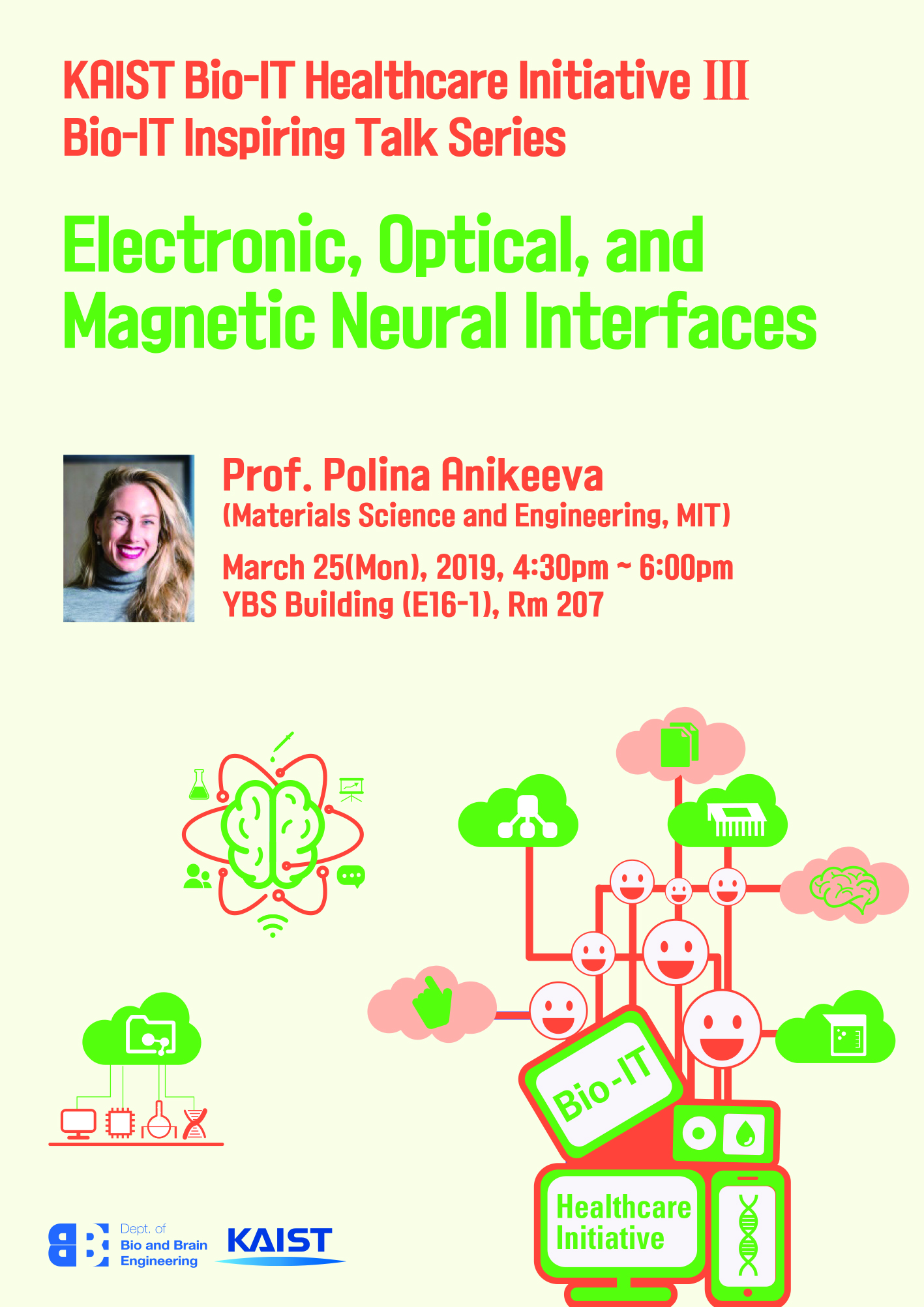| 연사 | Professor Polina Anikeeva |
|---|---|
| 소속 | MIT |
| 일시 | 2019.03.25(Mon) PM4:30~6:00 |
| 장소 | 양분순(E16-1), #207호 |

3/25(월) 4:30pm, 바이오및뇌공학과의 KAIST Bio-IT Healthcare Initiative III : Bio-IT Inspiring Talk Series에 최근 Neural Interfaces 분야에 많은 업적을 쌓고 계시는 MIT Polina Anikeeva 교수님(http://www.rle.mit.edu/bioelectron/)을 모시고 강연을 개최합니다. 여러분들의 많은 관심과 참여 부탁드립니다.
KAIST Bio-IT Healthcare Initiative III– Bio-IT Inspiring Talk Series
1. 제목 : Electronic, Optical, and Magnetic Neural Interfaces
2. 연사 : Polina Anikeeva 교수 (MIT)
3. 일시 및 장소 : 2019년 3월 25일 (월) 4:30~6:00PM, 양분순빌딩(E16-1) 207호
4. 초록: To understand the function and dynamics of the nervous system and to find treatments for the neurological and psychiatric conditions that increasingly affect our aging society, new tools capable of addressing neuronal signaling complexity are urgently needed. These tools must also match the mechanical and chemical properties of the neural tissue to avoid foreign body response and functional perturbation to local circuits. By leveraging fiber-drawing methods from the telecommunications industry, our group creates flexible and stretchable probes capable of recording and stimulation of neural activity as well as delivery of drugs and genes into the brain and spinal cord. We use these probes to interrogate brain circuits, such as those involved in anxiety and fear, and to promote recovery following spinal cord and nerve injury. Simultaneosly, we develop a broad range of magnetic nanotransducers that convert externally applied magnetic fields into thermal, chemical, and mechanical signals, which can then be perceived by ion channels on neurons. Since biological tissues exhibit negligible magnetic permeability and low conductivity, magnetic fields can penetrate deep into the body with no attenuation allowing us to apply the nanomagnetic transducers to remotely control deep brain circuits associated with reward and motivation as well as adrenal circuits involved in regulation of corticosterone and (nor)epinephrine release.
5. 약력: Professor Polina Anikeeva received her BS in Physics from St. Petersburg State Polytechnic University in 2003. After graduation she spent a year at the Los Alamos National Lab working on quantum dot photovoltaic cells. She then enrolled in a PhD program in Materials Science at MIT and graduated in January 2009 with her thesis dedicated to the design of light emitting devices based on organic materials and nanoparticles. She completed her postdoctoral training at Stanford, where she created devices for optical stimulation and recording from neural circuits. In 2011, Polina joined the Department of Materials Science and Engineering at MIT, where she is now an Associate Professor. Her lab focuses on the development of flexible and minimally invasive materials and devices for neural recording, stimulation, and repair. Polina is a recipient of NSF CAREER Award, DARPA Young Faculty Award, the TR35, and 2018 Vilcek Prize for Creative Promise among other honors.
※등록은 따로 필요치 않습니다.






